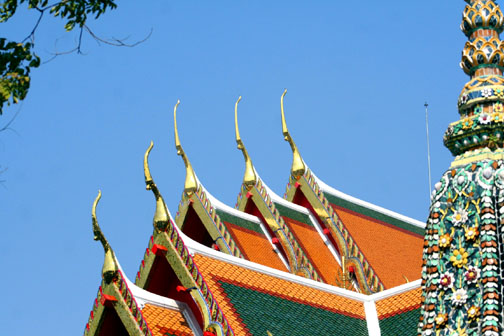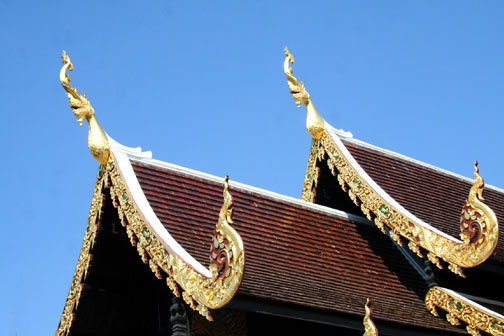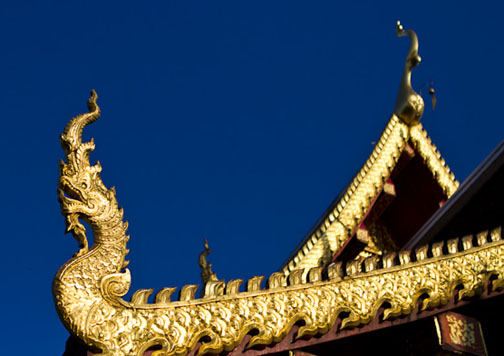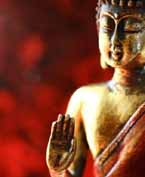Tags
According to Wikipedia, the English translation for chofah is ‘sky tassel’ which is a lot cooler than the Thai version that sounds like a sneeze. Not that the architectural details that top the roof lines of Thai wats are anything to sneeze about. As with most ornamentation on Thai temples, they have a meaning and a story; they don’t end up in such a prominent position purely by chance. But while their significance is not in question, just what they are supposed to represent often is.
Chofah are most often seen in the form of a stylized garuda, the mythical eagle-like creature of Buddhist legend by way of Hinduism. When there is a sharp break present, that’s probably a correct call. Gracefully flowing chofah that still have a bird-like appearance, some claim, are hongse instead. Which is also from Buddhist/Hindu myth, is sometimes called a hamsa instead, looks more like a swan than an eagle (though it is at times referred to as a male goose too), and is featured on the prow of the King of Thailand’s royal barge.
It doesn’t help that unlike much Thai art and ornamentation chofah are usually simple, yet sublime in design. Often their shape is suggestive with a minimum of detail. Some chofah are so heavily stylized you can’t be sure which bird-like creature they represent, and actually are supposed to be naga instead. There is also a version that look like a poorly rendered garuda, but is actually supposed to be a seated Buddha. Those shaped like an elephant, fortunately, are easily to figure out.
Also a well-used detail in Lao and Cambodian temples, it has been suggested that Hindu inspired chofah were originally intended to appease and appeal to those of that religion when the area was slowly moving to being predominately Buddhist. There is no arguing that the deities of the two religions are well-represented in SE Asian Buddhism. Some have even claimed the garuda//hongse debate on chofah is due to specific wats or areas attempting to appeal to specific Hindu belief systems; the garuda was the vehicle for the god Vishnu, the hongse the mount for the god Brahma. That theory has little to do with chofah that are shaped as a naga though, as he is the half sibling of the garuda and its sworn enemy.
Regardless of the design, chofah almost always are spiked. The belief is that its chofah protect a temple from flying demons; should an evil spirit fall from the sky it will be impaled on the point of the chofah and be unable to cause harm to the religious community. Which is even cooler than the sky tassel thingy.
And regardless of the design, what they are not are hang hong. A wat’s chofah are always at the peak of the roof, even when there are several peaks. Hang hong, which are almost always in the form of naga heads (though hongse are popular as hang hong too), are part of the roof’s bargeboards. They cover the ends of gables to prevent roof tiles from falling off. Which is more practical than spiking evil demons but not nearly as cool. But then it is position, not mythological creature that matters. And the naga used as hang hong too are generally considered part of a temple’s protection against danger, evil, and harm.
Related Posts You Might Enjoy:










Trivia on your 12/21/11 photo of Wat Sadoe Muang — it’s of recent construction and if you look at the photo, you’ll see that one chofah is missing on the higher tier roof peak (right or east side of building). There is rebar almost visible to attach a chofah. There is also rebar less visible to attach a dok so fa in the middle of the roof. The building is the same way today as in your photo.
During this month’s Inthakin festival at Wat Chedi Luang, they have opened a new building for the city pillar. People were making donations and then applying little sheets of gold leaf to chofah for that building.
Thanks Mitch.
Whenever I see a special gold leaf effort at a wat I do my part ‘cuz then later when I visit again I can say I helped do that.
yes. It really is all about me.
🙂
It just dawned on me: Rebar!!!
I guess that maks sense. Just always thought there was something more special used to attach the ornamentation.
🙁
If the rebar is blessed by nine monks, is it then special? I went to an unusual festival yesterday with nine monks chanting, one dead buffalo, and loose dogs gnawing on the carcass. http://chiangmaibest.com/pu-sae-ya-sae/ You would have liked it! Not that you are unusual, but you would give it a better write-up than BooHoo’s “tiptoe through the tulips” prose.
Just found a video from yesterday’s festival: http://www.youtube.com/watch?v=CDj4GW1YKII
Sweet!
Out of curiosity Mitch, how did you hear about that in advance?
I know there are always celebrations and stuff going on both in Chiang Mai and Bangkok, but have never found a good source to find out about them until it’s too late.
“nine monks chanting, one dead buffalo, and loose dogs gnawing on the carcass”
lol
Actually that does sound like my kind of event!